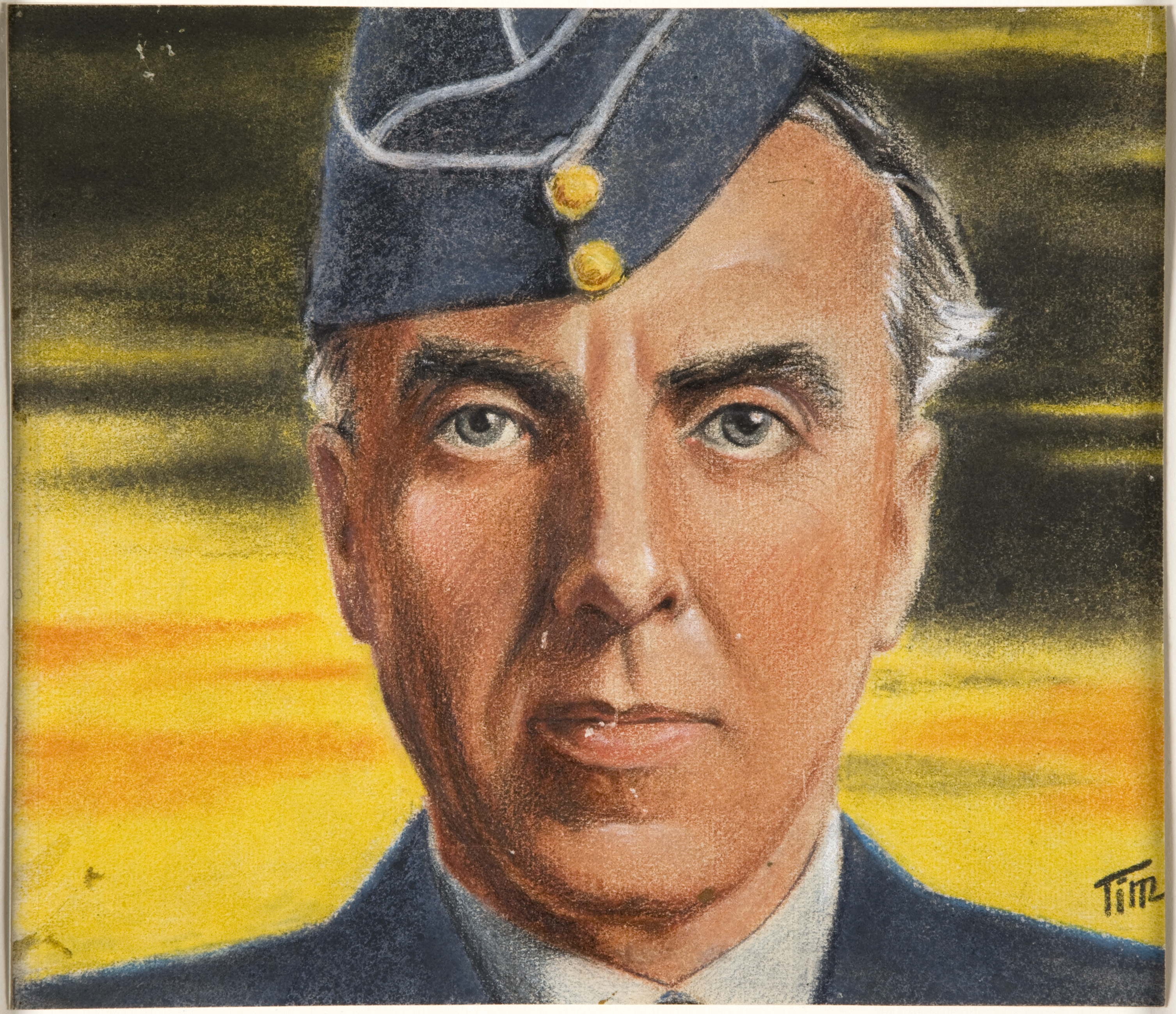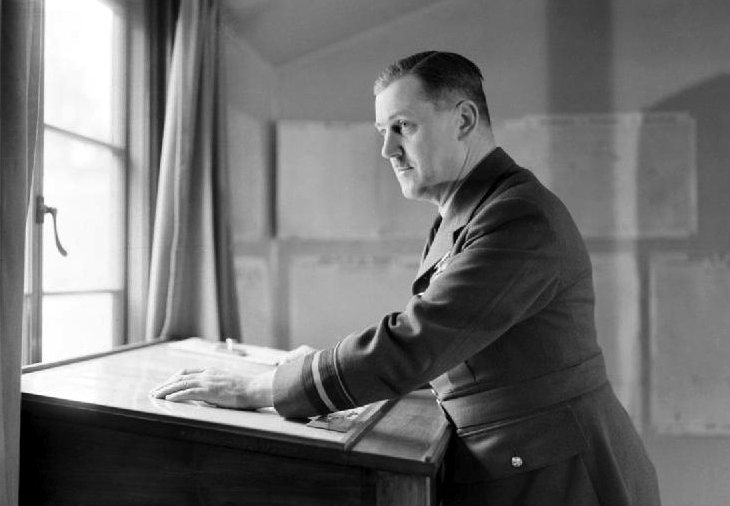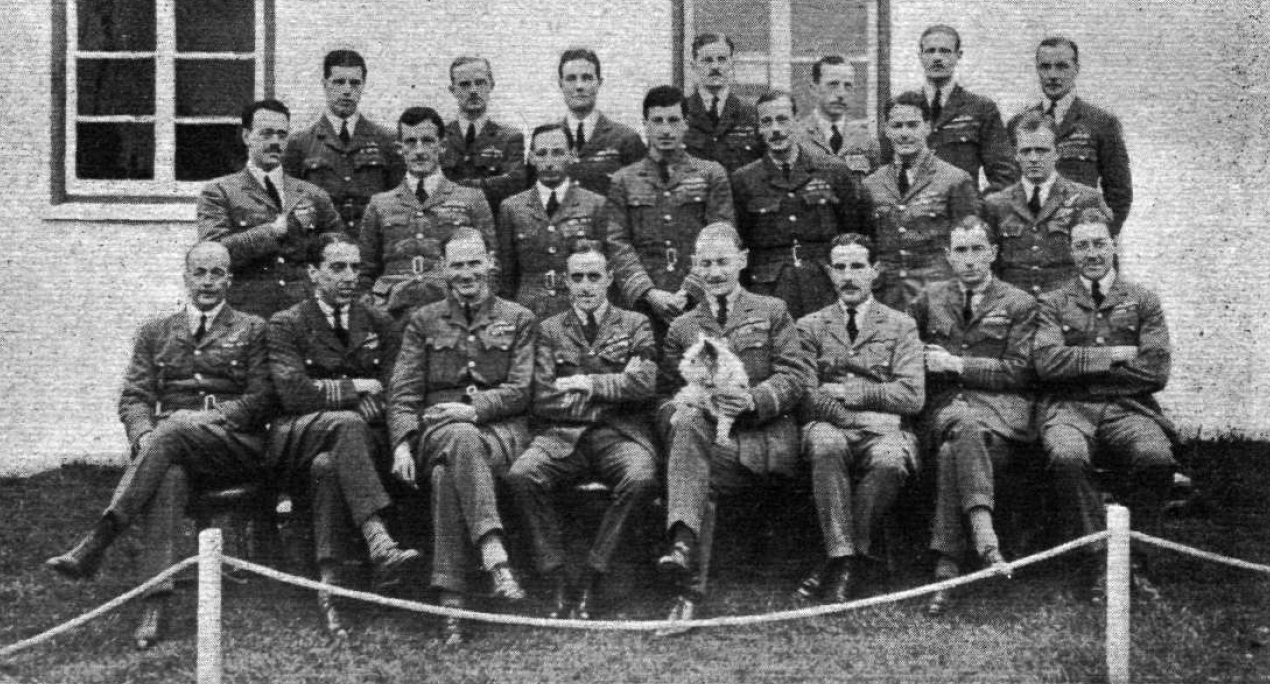|
Guy Garrod
Air Chief Marshal Sir Alfred Guy Roland Garrod, (13 April 1891 – 3 January 1965) was a senior British Royal Air Force officer. RAF career He was born the third eldest son of Herbert Baring Garrod, barrister-at-law and educated at Bradfield College and University College, Oxford. Garrod was originally commissioned into The Leicestershire Regiment of the British Army in 1914 and only transferred to the Royal Flying Corps in 1915. His younger brother Roland Perceval Garrod was killed in action the same year. Garrod was given the temporary rank of major in the newly formed Royal Air Force in April 1918. He joined the Directing Staff at the RAF staff College in 1923 and then became Chief Instructor at Oxford University Air Squadron in 1928 before moving to RAF Headquarters in Iraq in 1931. He was made Deputy Director of Organisation at the Air Ministry in 1934 and Air Officer Commanding the Armament Group in 1937. He served in the Second World War initially as Director of Equipme ... [...More Info...] [...Related Items...] OR: [Wikipedia] [Google] [Baidu] |
Adastral House
Television House is the former name of a building on Kingsway (London), Kingsway in London. From 1918, it was the base of the Air Ministry, and later from 1955, was the headquarters of Associated-Rediffusion/Rediffusion London, Independent Television News (ITN), ''TV Times'' magazine, the Independent Television Companies Association and, at first, Associated Television. Later, It was the initial base for its successor, Thames Television. After Thames moved out, it was the headquarters of the General Register Office and subsequently of ExxonMobil. It is now known as 61 Aldwych. History Adastral House The Kingsway area had been redeveloped at the start of the 20th century from slums and Apartment building, tenement housing into a broad avenue with grand office buildings and expensive townhouses. After the formation of the Air Ministry in 1918, its headquarters was on Kingsway; one of two identical buildings opposite Bush House became Adastral House, the name being derived from the ... [...More Info...] [...Related Items...] OR: [Wikipedia] [Google] [Baidu] |
Order Of The Cloud And Banner
The Order of the Cloud and Banner () also known as the Order of the Resplendent Banner is a military award of the Republic of China. It was instituted on June 15, 1935 and is awarded in nine grades for contributions to national security. The insignia of the order features a fluttering yellow flag, surrounded by white clouds on a blue field. This image is surrounded by golden rays. Grades The order is divided into nine grades, they are as follows: Recipients International * Edward McGill Alexander * John R. Allen * Henry H. Arnold * Claude Auchinleck * Robert O. Bare * Gilbert Bartholomew RAF British Air Attaché to China 1943-46 * John Birch (missionary) * Alan Bruce Blaxland * Charles Bond (pilot) * Leslie Bonnet * Wilburt S. Brown * Joseph J. Cappucci * Bernard Chacksfield * Prince Charles, Count of Flanders * Levi R. Chase * Claire Lee Chennault * Philip Christison * Vasily Chuikov * Gareth Clayton (RAF officer) * William T. Clement * Henry Crowe (RAF officer) * Andr ... [...More Info...] [...Related Items...] OR: [Wikipedia] [Google] [Baidu] |
Keith Park
Air Chief Marshal Sir Keith Rodney Park, (15 June 1892 – 6 February 1975) was a New Zealand-born officer of the Royal Air Force (RAF). During the Second World War, his leadership of the RAF's No. 11 Group was pivotal to the Luftwaffe's defeat in the Battle of Britain. Born in Thames, Park was a mariner when he enlisted in the New Zealand Expeditionary Force for service in the First World War. Posted to the artillery, he fought in the Gallipoli campaign, partway through which he transferred to the British Army. On the Western Front, he was present for the Battle of the Somme and was injured. He obtained another transfer, this time to the Royal Flying Corps. Once his flight training was completed, he served as an instructor before being posted to serve with No. 48 Squadron on the Western Front. He became a flying ace, achieving a number of aerial victories and eventually becoming commander of the squadron. In the postwar period, he served with the RAF in a series of comm ... [...More Info...] [...Related Items...] OR: [Wikipedia] [Google] [Baidu] |
Richard Peirse
Air Chief Marshal Sir Richard Edmund Charles Peirse, (30 September 1892 – 5 August 1970), served as a senior Royal Air Force commander. RAF career The son of Admiral Sir Richard Peirse and his wife Blanche Melville Wemyss-Whittaker, Richard Peirse was educated at the Junior School section of Monkton Combe School, Bath, Somerset, on and at King's College London. He became a midshipman in the Royal Navy Volunteer Reserve and was commissioned in 1912.Air of Authority – A History of RAF Organisation – Air Chief Marshal Sir Richard Peirse He was awarded the for his contribution ... [...More Info...] [...Related Items...] OR: [Wikipedia] [Google] [Baidu] |
Trafford Leigh-Mallory
Air Chief Marshal Sir Trafford Leigh-Mallory, (11 July 1892 – 14 November 1944) was a senior commander in the Royal Air Force. Leigh-Mallory served as a Royal Flying Corps pilot and squadron commander during the First World War. Remaining in the newly formed RAF after the war, Leigh-Mallory served in a variety of staff and training appointments throughout the 1920s and 1930s. During the pre-Second World War build-up, he was Air Officer Commanding (AOC) No. 12 (Fighter) Group and shortly after the end of the Battle of Britain, took over command of No. 11 (Fighter) Group, defending the approach to London. In 1942 he became the Commander-in-Chief (C-in-C) of Fighter Command before being selected in 1943 to be the C-in-C of the Allied Expeditionary Air Force, which made him the air commander for the Allied Invasion of Normandy. In November 1944, en route to Ceylon to take up the post of Air Commander-in-Chief South East Asia Command, his aircraft crashed in the French Alps and L ... [...More Info...] [...Related Items...] OR: [Wikipedia] [Google] [Baidu] |
South East Asia Command
South East Asia Command (SEAC) was the body set up to be in overall charge of Allies of World War II, Allied operations in the South-East Asian theatre of World War II, South-East Asian Theatre during the World War II, Second World War. History Organisation The initial supreme commander of the theatre was General (United Kingdom), General Archibald Wavell, 1st Earl Wavell, Sir Archibald Wavell while head of the short-lived American-British-Dutch-Australian Command (ABDACOM) which was dissolved after the Battle of Singapore, fall of Singapore and the Dutch East Indies. Afterwards, Allied forces in the region were divided between SEAC and the South West Pacific Area command (SWPA). In August 1943, the Allies of World War II, Allies created the combined South East Asian Command, to assume overall strategic command of all air, sea and land operations of all national contingents in the theatre. In August 1943, with the agreement of the Combined Chiefs of Staff, Winston Churchill ap ... [...More Info...] [...Related Items...] OR: [Wikipedia] [Google] [Baidu] |
Air Ministry
The Air Ministry was a department of the Government of the United Kingdom with the responsibility of managing the affairs of the Royal Air Force, that existed from 1918 to 1964. It was under the political authority of the Secretary of State for Air. Organisations before the Air Ministry The Air Committee On 13 April 1912, less than two weeks after the creation of the Royal Flying Corps (which initially consisted of both a naval and a military wing), an Air Committee was established to act as an intermediary between the Admiralty and the War Office in matters relating to aviation. The new Air Committee was composed of representatives of the two war ministries, and although it could make recommendations, it lacked executive authority. The recommendations of the Air Committee had to be ratified by the Admiralty Board and the Imperial General Staff and, in consequence, the Committee was not particularly effective. The increasing separation of army and naval aviation from 191 ... [...More Info...] [...Related Items...] OR: [Wikipedia] [Google] [Baidu] |
Oxford University Air Squadron
The Oxford University Air Squadron, abbreviated Oxford UAS, or OUAS, formed in 1925, is the training unit of the Royal Air Force at the University of Oxford and forms part of the Royal Air Force Volunteer Reserve. OUAS is one of fifteen University Air Squadrons that are spread out across Great Britain and it recruits from the universities at Oxford (Oxford University and Oxford Brookes) and Reading University. Present day University Air Squadrons offer basic flying training and adventure training to undergraduates and graduates and encourage members to take up a career as an officer in one of the branches of the Royal Air Force. Some members of OUAS hold the title of Officer Cadet, which carries the privileges, but not the rank, of a commissioned officer, while some other members are also granted commissions in the RAF Volunteer Reserve, with the rank of Acting Pilot Officer. Officer Cadets are required to attend a minimum of one training night a week during full term, usually ... [...More Info...] [...Related Items...] OR: [Wikipedia] [Google] [Baidu] |
RAF Staff College, Andover
The RAF Staff College at RAF Andover was the first Royal Air Force staff college to be established. Its role was the training of officers in the administrative, staff and policy aspects of air force matters. History Foundation Following the foundation of the RAF in April 1918 and the end of the First World War in November 1918, there was a determination to maintain the Air Force as an independent service rather than let the Army and Royal Navy control air operations again. Therefore, the creation of an RAF Staff College to parallel the Army Staff College and the Royal Naval Staff College was an important element in fully establishing the RAF. On 14 November 1921, Air Commodore Robert Brooke-Popham was tasked with setting up the RAF Staff College. On 1 April the following year, the new RAF Staff College came into being with Brooke-Popham as its first commandant. The Staff College was based at RAF Andover and was subordinate to Inland Area. The dog seen in the photograph on R ... [...More Info...] [...Related Items...] OR: [Wikipedia] [Google] [Baidu] |
Royal Flying Corps
"Through Adversity to the Stars" , colors = , colours_label = , march = , mascot = , anniversaries = , decorations = , battle_honours = , battles_label = Wars , battles = First World War , disbanded = merged with RNAS to become Royal Air Force (RAF), 1918 , current_commander = , current_commander_label = , ceremonial_chief = , ceremonial_chief_label = , colonel_of_the_regiment = , colonel_of_the_regiment_label = , notable_commanders = Sir David HendersonHugh Trenchard , identification_symbol = , identification_symbol_label = Roundel , identification_symbol_2 = , identification_symbol_2_label = Flag , aircraft_attack = , aircraft_bomber = , aircraft_el ... [...More Info...] [...Related Items...] OR: [Wikipedia] [Google] [Baidu] |
The Leicestershire Regiment
The Leicestershire Regiment (Royal Leicestershire Regiment after 1946) was a line infantry regiment of the British Army, with a history going back to 1688. The regiment saw service for three centuries, in numerous wars and conflicts such as both World War I and World War II, before being amalgamated, in September 1964, with the 1st East Anglian Regiment (Royal Norfolk and Suffolk), the 2nd East Anglian Regiment (Duchess of Gloucester's Own Royal Lincolnshire and Northamptonshire) and the 3rd East Anglian Regiment (16th/44th Foot) to form the present day Royal Anglian Regiment, of which B Company of the 2nd Battalion continues the lineage of the Royal Leicestershire Regiment. History Early wars On 27 September 1688 a commission was issued to Colonel Solomon Richards to raise a regiment of foot in the London area. In its early years, like other regiments, the regiment was known by the name of its various colonels. Following a failed attempt to break the siege of Derry in 1689 ... [...More Info...] [...Related Items...] OR: [Wikipedia] [Google] [Baidu] |







